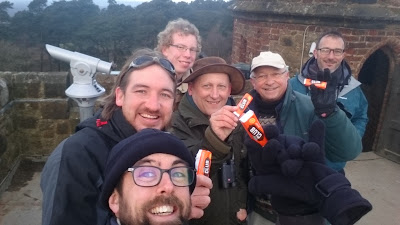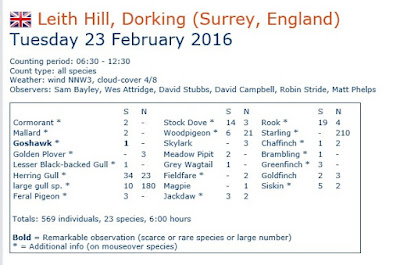It's been two years now since National Trust ranger Sam Bayley first mooted the idea of a visible migration watch at his work place of Leith Hill near Dorking - the highest point in south-east England. Indeed, standing atop the tower you are looking down on The Shard and, if you were to go east, the next highest point is in the Ural Mountains, as Sam always used to love to tell visitors up the tower. So on 5th April 2014 the first group of birders gathered (in a sea of fog, mind!) and since then almost 400 hours of 'vis-migging' have been carried out up the tower, producing well over a hundred species - quite a remarkable feat when you consider the observers remain largely static on the roof which is just a few metres square.
 |
| Leith Hill Tower panorama - photo by David Campbell |
After a rather late start to the first migration watching season in 2014, in 2015 we opted to begin on 1st March and this year we decided on an even earlier date - 23rd February - mainly because Sam is upping sticks and moving to Ireland. It's no exaggeration to say that Sam has totally put Leith Hill on the map with his ringing and birding efforts up there, not to mention of course the tower watches. He will be missed but we will do our best to carry on his legacy!
 |
| Sam Bayley with Buzzard |
So it was that four of us - David Stubbs, Robin Stride, Sam and I - convened at first light on Tuesday and made our way up to the tower, where we were soon joined by Wes Attridge and David Campbell, who'd unfortunately got held up en route.
It was a frosty morning and there was a chilly breeze blowing in from the North Downs, and it's fair to say that none of us were exactly expecting fireworks on the migration side of things.
 |
| Looking south-east from Leith Hill towards Gatwick |
We'd soon added plenty of common species to the day list - including at least two hooting male Tawny Owls - before we spotted a Woodlark displaying over Duke's Warren to the north-east; the hill's largest area of open heathland. Throughout the course of the morning we recorded at least four displaying birds, their 'too-lueet' calls occasionally reaching us on the breeze. It was quite something to watch them hanging in the air in front of the London skyline, as Robin so perfectly described later on Twitter.
Apart from being a great sight in their own right, the Woodlarks proved useful in helping us find other birds, as it was while watching them that Wes picked up three Golden Plover heading north-west distantly over the downs. Unfortunately not everyone got on the birds but as it was a new species for Leith Hill it meant it was time for David S to break out the now traditional orange Club biscuits in celebration!
 |
Other species on the move included quite a few Rooks - not a particularly common sight up the hill - and lots of Herring Gulls, the odd Lesser Black-backed and Black-headed amongst them. Other than 210 Starlings east in two flocks, passerines were fairly thin on the ground with just a few Siskins, Chaffinches, Greenfinches and Goldfinches past, plus two Fieldfare east, one Brambling west and two Meadows Pipits and a Grey Wagtail south.
David Stubbs unfortunately had to leave us mid-morning which we joked would mean all the best birds would appear. The sun was out by now and the air was perceptibly warming, and by 10:30 there were good numbers of raptors in the sky including at least a dozen Buzzards. Just after 10:40 Wes and David S picked up a Sparrowhawk to the north-east. David Campbell thought he'd got on the same bird but quickly realised this bird was no Sparrowhawk. Soon we'd all got on it, and over the course of the next half hour were treated to phenomenal views of the young female Goshawk as it thermalled around the tower at close range, before drifting powerfully south/south-east at 11:12. David Campbell managed to capture some excellent phone-scope footage of it.
In all we recorded 55 species in almost six hours. Not a bad start to the 2016 Leith Hill vis-mig season and a very fitting send-off for Mr Bayley. Roll on the next tower watch!
 |
| Results of tower watch on Trektellen |



















